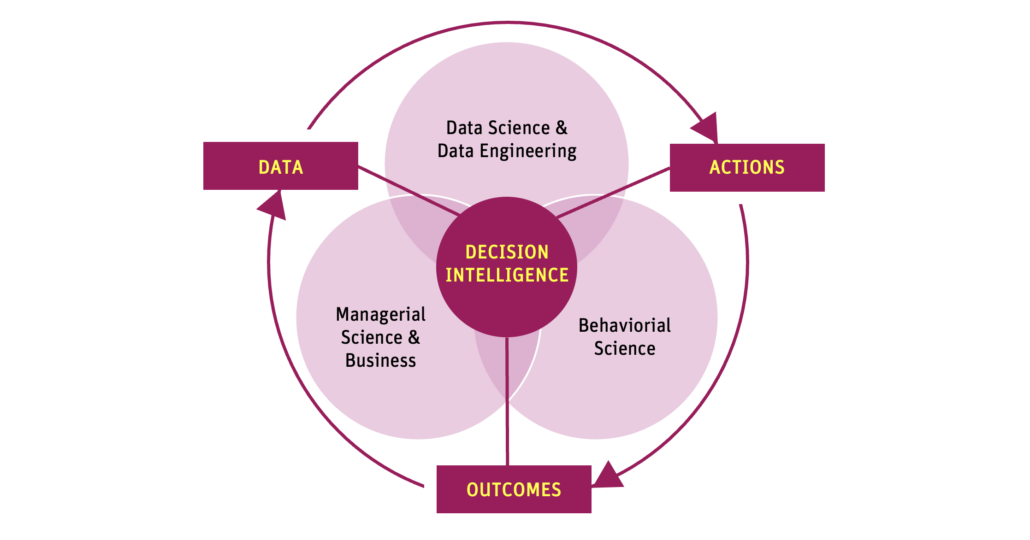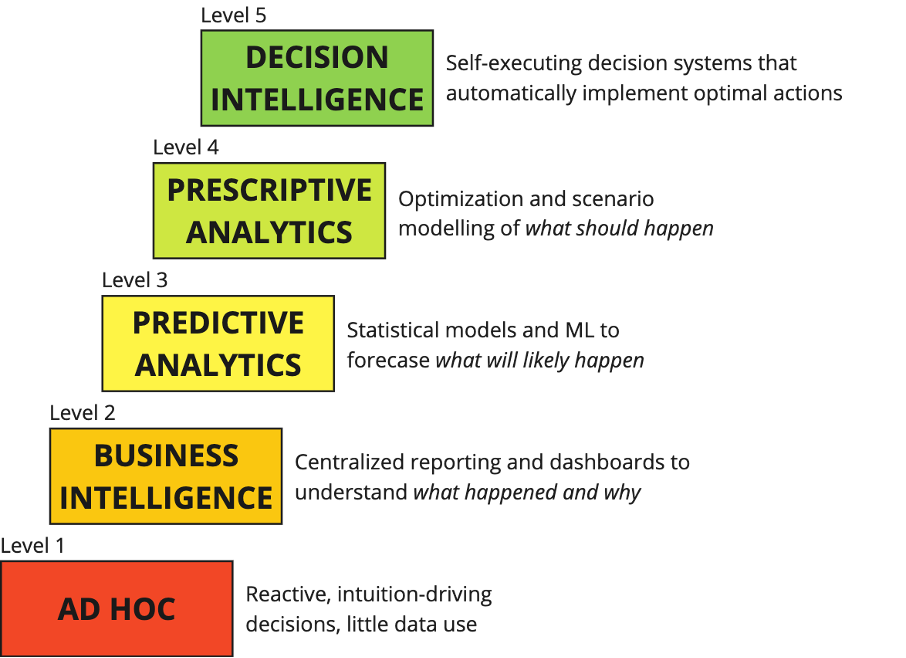Decision Intelligence: The Bridge Beween AI Investment and Impact, Part 1
Decision Intelligence is exploding. Despite massive investment in AI and data, 70-80% of projects fail to deliver results. Algorithms generate predictions, not better choices. DI reframes the field: it starts with outcomes, maps the decisions that shape them, and builds feedback loops that drive measurable impact. It is the missing layer between technology investment and real business value. In two parts, Kenneth Ritley and Benjamin Baer provide insight into decision intelligence.

What is Decision Intelligence?
Decision Intelligence is a discipline that combines data science, behavioral science, decision theory, and deep business knowledge to improve how organizations make choices. It uses data and analytics not just to describe the past or predict the future, but to guide better decisions. It considers the full decision-making process, embedding outcomes within their business context, including processes, objectives and constraints. It includes framing the right questions and recognizing human cognitive biases, to designing systems that present information in actionable ways.
The key insight is simple: good data and accurate models are not enough if people cannot or will not use them effectively. DI bridges this gap by integrating the technical (algorithms, data) with both the human (psychology, organizational dynamics) and business (processes, supply chain, risk tolerances, offers) in order to shape real-world outcomes.
A Discipline at the Top of the Maturity Curve
Seen in historical context, DI represents the fifth stage in the evolution of analytics. Organizations began with ad hoc, intuition-driven decisions, moved through descriptive and diagnostic reporting, then into predictive and prescriptive analytics. Decision Intelligence now sits at the top of this maturity model, integrating human and machine intelligence into end-to-end decision flows, embedding feedback loops, and aligning them with organizational context.

Decision Intelligence Maturity Model (5 Levels)
By positioning DI explicitly within this continuum, we recognize it as both a culmination of prior developments and a new departure: whereas earlier stages focused on hindsight or foresight, DI establishes a discipline of decision architecture, integrating data, models, and human judgment into systems that are governed, adaptive, and outcome-driven.
Feedback Loops and Human Factors
An essential feature of DI is the use of feedback loops. Decisions are rarely one-off events; they repeat, evolve, and influence each other over time. DI builds mechanisms to monitor outcomes, compare them with expectations (from models, forecasts, strategic goals, or even digital twins), and refine the decision process. Without these loops, organizations cannot learn whether their AI-enabled decisions are working or not.
Equally critical are human factors. Business knowledge, strategic context, and organizational culture all shape decision quality. DI therefore insists on a holistic view in which human judgment and machine intelligence complement one another. This is the essence of keeping the human in the loop: ensuring that automation and AI enhance, rather than replace, human decision-making. In this sense, DI is as much about management science as it is about computer science.
A Simplified Model
There is not yet an established, universally recognized approach to Decision Intelligence, but such approaches are beginning to emerge. Pratt and Malcolm describe one in the form of a five-phase methodology: requirements, modelling, reasoning, action, and review. At its heart is a simple sequence: first clarify the outcomes you want to achieve, then identify the decisions that shape those outcomes, and only then determine what data, models, or information are needed to support them. Many AI projects fail because they reverse this order, beginning with data and algorithms rather than with outcomes and choices. Existing models, such as Data Science PM (2025), trace the evolution of analytics capabilities but do not yet constitute a full methodology for decision flows.
This is not a loose framework but a formal model with defined artefacts, stakeholder roles such as a decision team, and even the use of simulation results to anticipate and compare alternative courses of action. The final phases of action and review turn the methodology into a continuous improvement cycle, embedding feedback loops that allow decisions and their supporting systems to learn and self-improve over time.
Illustrative Examples
Consider three examples. In credit risk management, machine learning models can predict the probability of default with high accuracy, but the real decision is whether to extend credit under regulatory, ethical, and strategic constraints. In supply chain management, predictive analytics may forecast demand spikes, yet the decision of how much inventory to allocate involves trade-offs across cost, service levels, resilience, and customer satisfaction. In healthcare, AI systems can flag anomalies in medical images, but the critical decision is how to balance algorithmic advice with clinical judgment, patient preferences, and liability concerns. Taking a Decision Intelligence approach provides a structured framework that makes such choices reproducible, transparent, and self-improving through feedback loops. Most importantly, this closes the gap where so many AI projects fail.
Toward Decision Architecture
The gains from Decision Intelligence will remain limited and often painfully expensive unless an established practice of decision architecture emerges. Just as software, networks, and enterprises only reached their full potential once architecture disciplines matured, decision-making now requires the same: a systematic way to design how decisions are identified, structured, automated, and governed — and especially, how AI is embedded into those flows.
Such an architecture requires practitioners who can span domains: grounded in business, fluent in technology, and oriented toward strategy and vision. It also requires the infrastructure of a mature field, such as taxonomy, frameworks, standards, role descriptions, and a recognized body of knowledge. At present, these elements are largely absent. Without them, organizations will continue to repeat the pattern of failed projects.
Why Decision Intelligence Matters Now
The urgency is clear. AI and data capabilities are advancing rapidly, but value creation remains elusive. Decision Intelligence provides the missing link by ensuring that technology is aligned with the choices that determine outcomes. It reframes AI as a means, not an end.
If AI and machine learning are the engines, then DI is the navigation system. It ensures that enormous computational power is directed toward destinations that matter and business outcomes that are achieved. Without DI, organizations risk building ever faster engines that take them nowhere. With it, they can transform investments into measurable results, reducing the failure rate of AI projects from today’s unacceptable levels to a fraction. Crucially, what proves effective in one industry or use case may fail in another; the nuances of sector, strategy, and context matter. Therefore, sharing best practices (such as what was attempted, why it succeeded, and why it did not) is essential to collective progress. We are not starting from scratch, but the discipline of DI will only mature if organizations collaborate to codify lessons learned and adapt them to broader conceptual frameworks.
References
- Lorien Pratt, The Decision Intelligence Handbook: Practical Steps for Evidence-Based Decisions in a Complex World, Emerald Publishing, 2022.
- Cassie Kozyrkov, “Decision Intelligence: The New Discipline of Business,” Google Cloud Blog, 2019.
- Gartner Research, “Decision Intelligence: A Practitioner’s Guide,” Gartner, 2021.
- Sam Ransbotham, Shervin Khodabandeh, David Kiron, “Winning With AI Is a Decision, Not a Data Science Problem,” MIT Sloan Management Review, 2021.
- Data Science PM, “Data Science Maturity Model,” Data Science PM, 2025. Available at: https://www.datascience-pm.com/data-science-maturity-model/
 Create PDF
Create PDF


 Contributions as RSS
Contributions as RSS Comments as RSS
Comments as RSS
Leave a Reply
Want to join the discussion?Feel free to contribute!